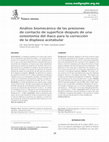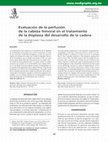Papers by Pablo Castaneda
The bone & joint journal, Feb 1, 2024
Journal of Bone and Joint Surgery, American Volume, Apr 24, 2020

Revista Mexicana de ortopedia pediátrica, 2014
Método: Se determinó la presión de superficie contacto de 70 caderas utilizando el programa HipSt... more Método: Se determinó la presión de superficie contacto de 70 caderas utilizando el programa HipStress que es un nomograma calculado. El análisis se llevó a cabo con correlaciones de Spearman y Pearson. La edad media de los pacientes al momento del análisis fue de 7.5 años. Resultados: La media de HipStress para caderas sanas usadas como control fue de 1.66 Mpa, para caderas con displasia fue 8.9 MPa, después de una osteotomía de Salter fue de 2.9 y después de una osteotomía tipo Pemberton fue de 3.1. El cambio en el HipStress fue de -4.7 después de una osteotomía tipo Salter (p = 0.003) y fue de -5.5 después de una osteotomía tipo Pemberton (p = 0.004). Conclusión: Tanto la osteotomía tipo Salter como la tipo Pemberton tienen el potencial de reducir el valor de HipStress en pacientes con displasia. La reducción de la presión de contacto de superficie debe traducirse en una articulación más duradera. Nivel de evidencia: III

Bulletin of the Hospital for Joint Disease, 2021
Traction apophysitises are a well-known entity in the orthopedic world that are generally thought... more Traction apophysitises are a well-known entity in the orthopedic world that are generally thought of as conditions of the pediatric population secondary to overuse and repetitive microtrauma. Many have been named for their original descriptors, and therefore the purpose of this review is to highlight the backgrounds of these physicians, pay tribute to those who came before, and standardize the definitions of these oft-used eponyms. Iselin's disease, Little League Elbow, Osgood-Schlatter disease, Sever's disease, and Sinding-Larsen-Johansson disease will be discussed in brief, followed by a historical background presenting the original description of the named author as well as a short biography. A particular focus on imaging findings will be presented, from original roentgenographs to current modalities of both ultrasonography and magnetic resonance imaging.
Acta ortopédica mexicana, 2006
Revista Mexicana de ortopedia pediátrica, 2013

Revista Mexicana de ortopedia pediátrica, 2013
La complicación más temida en el tratamiento de la displasia en el desarrollo de la cadera es la ... more La complicación más temida en el tratamiento de la displasia en el desarrollo de la cadera es la necrosis avascular; se trata de una condición netamente iatrogénica, ya que no ocurre en caderas sin tratamiento; tiene una incidencia variable informada en la literatura, que va desde cero hasta el 73%. La causa exacta sigue siendo tema de controversia con un origen vascular siendo la teoría predominante, sin poder excluir un origen mecánico por presión en la condroepífisis de la cabeza femoral, el resultado final de cualquier proceso fisiopatológico es un estado de hipoperfusión de la cabeza femoral. Este artículo presentará una revisión de la fisiopatología y el estado actual de los métodos que permiten evaluar la perfusión de la cabeza, incluyendo el ultrasonido, Doppler y resonancia magnética contrastada; con un enfoque especial en su interpretación para la toma de decisiones en el tratamiento esta condición. Nivel de evidencia: IV Palabras clave: Displasia del desarrollo de la cadera, necrosis avascular, perfusión de la cabeza femoral.
Revista Mexicana de ortopedia pediátrica, 2010
Anales médicos (México, D.F.), 2003
Hip International, Jan 31, 2023
Revista Mexicana de ortopedia pediátrica, Oct 27, 2016
Revista Mexicana de ortopedia pediátrica, Aug 18, 2016
Acta ortopédica mexicana, 2006
Revista Mexicana de ortopedia pediátrica, 2013
Revista Mexicana de ortopedia pediátrica, 2014
Journal of Pediatric Orthopaedics, Jan 11, 2021

The journal of hip surgery, Feb 4, 2022
Femoroacetabular impingement (FAI) can cause pain, dysfunction, and early arthritic progression i... more Femoroacetabular impingement (FAI) can cause pain, dysfunction, and early arthritic progression in young patients. The purpose of this study was to systematically review the evidence in literature to determine patient-reported outcomes and failure rates as defined by the need for revision surgery, following hip arthroscopy for pediatric patients with FAI. The literature search was performed based on the Preferred Reporting Items for Systematic Reviews and Meta-Analyses guidelines. Clinical studies evaluating the outcomes following primary hip arthroscopy for pediatric patients with FAI were included. Clinical outcomes evaluated included revisions, complications, functional outcome scores (modified Hip Harris Score [mHHS], Non-Arthritis Hip Score, and Visual Analogue Score), and return to play. Statistical analysis was performed using GraphPad Prism version 7. This study is a level IV systematic review. Overall, 20 clinical studies with 1,136 patients (1,223 hips) were included in this review, with an average age of 16.3 years. Overall, 8.6% patients experienced revision surgery. The mHHS was the most widely used metric, present in 17 of the 20 studies. The mHHS was reported as excellent (> 90) in six of these studies and good (80–89) in 11. The weighted mean of the post-operative mHHS found across reporting studies was 84.3, from a baseline score of 58.1. The overall return to play rate was 91%. This study reports excellent post-hip arthroscopy clinical outcomes for FAI and labral tears in the pediatric population. However, revision rates for this surgical procedure are higher than previously documented.

Journal of Pediatric Orthopaedics, Sep 16, 2021
Background: The Pavlik method for the treatment of developmental dysplasia of the hip (DDH) has b... more Background: The Pavlik method for the treatment of developmental dysplasia of the hip (DDH) has been proven successful for over 85 years. The high success rate and reproducibility have made it the mainstay of treatment. Methods: We performed a retrospective cohort study of patients with DDH treated with the Pavlik method between September 2016 and August 2018 with at least 24 months of follow up in a single academic center. We excluded patients with neuromuscular conditions, teratologic dislocations, and arthrogryposis. We identified and included a total of 307 patients in the analysis. There were 66 patients with dysplasia, 97 with instability, and 144 with a dislocation. Data collected included age at initiation of the Pavlik method, diagnosis (isolated dysplasia, subluxation, or dislocation), duration of treatment, follow up duration and any complication. At final follow up, anteroposterior radiographs of the pelvis were used to determine the Severin classification. Results: Major complications were proximal femoral growth disturbance (5.8%) and femoral nerve palsy (0.98%). Multivariate analysis showed that an initial diagnosis of a dislocated hip (odds ratio, 2.20; P<0.01), was significantly associated with developing a complication. At final follow up, we found Severin type I or II radiographic findings in 100% of patients with dysplasia, 95% of patients with instability and 54% of patients with dislocation (P=0.001). Conclusions: Complications are not entirely uncommon when the Pavlik method is used for the treatment of DDH. The overall rate of major complications was 7%. The Pavlik method is safe, and independent risk factors for complications were being over 5 months of age and having a dislocated hip at initial presentation. Level of Evidence: Level IV—cohort study.

Journal of Pediatric Orthopaedics, Jun 7, 2021
Background: We sought to determine if the age of patients presenting to a tertiary subspecialty h... more Background: We sought to determine if the age of patients presenting to a tertiary subspecialty hospital dedicated to pediatric orthopaedics has changed over the last 21 years and determine if a dedicated ultrasound-screening program implemented in 2006 made any difference. Methods: We reviewed the hospital charts for 9299 patients diagnosed with developmental dysplasia of the hip (DDH) and determined the age at the time of presentation; this was a consecutive series of all patients presenting between 1998 and 2019. We determined the diagnosis and age from the chart, 8011 were female (86.15%), and 1288 were male (13.85%). The left hip was affected in 4588 cases (49.34%), the right hip in 1824 cases (19.62%), and there were 2887 bilateral cases (31.05%). Results: Over the 21 years, the mean age of presentation was 2.36 years (range, 0.1 to 17 y). In 1998, the mean age was 2.49 years (range, 0.1 to 16 y). In 2006, a dedicated ultrasound-screening clinic was instituted. The mean age decreased to 1.70 years in 2019 (range, 0.1 to 14 y). The mean age at presentation decreased significantly from 2.65 years, between 1998 and 2005, to 2.19 between 2006 and 2019 (P=0.0067). Conclusions: The implementation of a dedicated ultrasound-screening protocol was significantly correlated with a decrease in the mean age of diagnosis of DDH. The results of treatment of DDH are known to be better the sooner the diagnosis is made. Given that the age of presentation remains a challenge, especially in developing countries, a dedicated ultrasound-screening program is one step to improve our ability to detect DDH in patients at a younger age. Level of Evidence: Level IV—diagnostic.

Clinical Orthopaedics and Related Research, Aug 5, 2021
Background Developmental dysplasia of the hip (DDH) is the most common disorder found in newborns... more Background Developmental dysplasia of the hip (DDH) is the most common disorder found in newborns. The consequences of DDH can be mitigated with early diagnosis and nonoperative treatment, but existing approaches do not address the current training deficit in making an early diagnosis. Question/purpose Can ultrasound be taught to and used reliably by different providers to identify DDH in neonates? Methods This was a prospective observational study of a series of neonates referred for an evaluation of their hips. An experienced clinician trained three second examiners (a pediatric orthopaedic surgeon, an orthopaedic resident, and a pediatrician) in performing an ultrasound-enhanced physical examination. The 2-hour training process included video and clinical didactic sessions aimed to teach examiners to differentiate between stable and unstable hips in newborns using ultrasound. The experienced clinician was a pediatric orthopaedic surgeon who uses ultrasound regularly in clinical practice. Materials required for training include one ultrasound device. A total of 227 infants (454 hips) were examined by one of the three second examiners and the experienced clinician (gold standard) to assess reliability. Of the 454 hips reviewed, there were 18 dislocations, 24 unstable hips, and 63 dysplastic hips, and the remainder had normal findings. The cohort was composed of a series of patients younger than 6 months referred to a specialty pediatric orthopaedic practice. Results Ultrasound-enhanced physical examination of the hip was easily taught, and the results were reliable among different levels of providers. The intraclass correlation coefficient between the gold-standard examiner and the other examiners for all hips was 0.915 (p = 0.001). When adjusting for only the binary outcome of normal versus abnormal hips, the intraclass correlation coefficient was 0.97 (p = 0.001). Thus, the agreement between learners and the experienced examiner was very high after learners completed the course. Conclusion After a 2-hour course, physicians were able to understand and reliably examine neonatal children using ultrasound to assess for DDH. The success of the didactic approach outlined in this study supports the need for ultrasound-enhanced examination training for the diagnosis of DDH in orthopaedic surgery and pediatric residency core curriculums. Training programs would best be supported through established residency programs. Expansion of training more residents in the use of ultrasound-enhanced physical examinations would require a study to determine its efficacy. This finding highlights the need for further research in implementing ultrasound-enhanced physical examinations on a broader scale. Level of Evidence Level II, diagnostic study.











Uploads
Papers by Pablo Castaneda